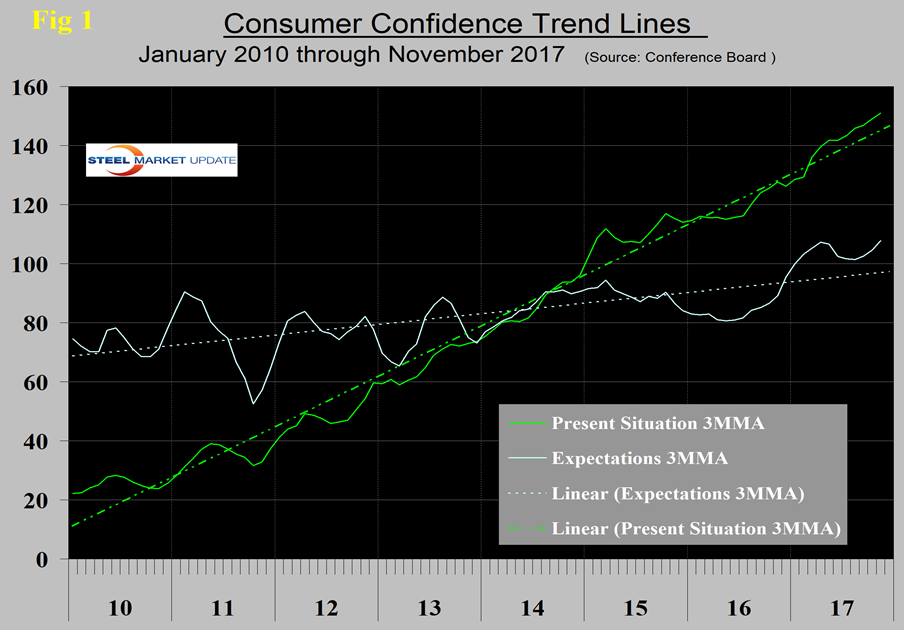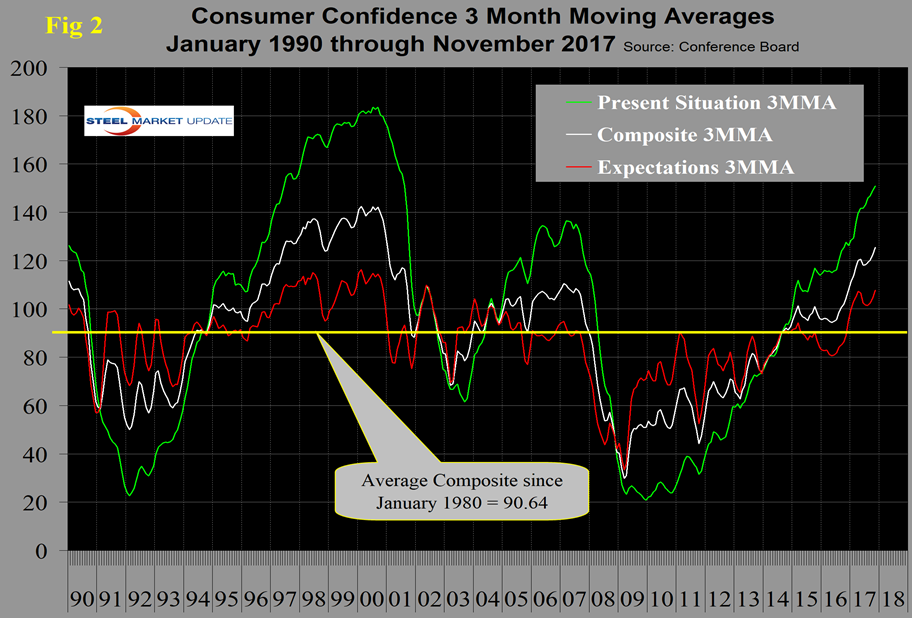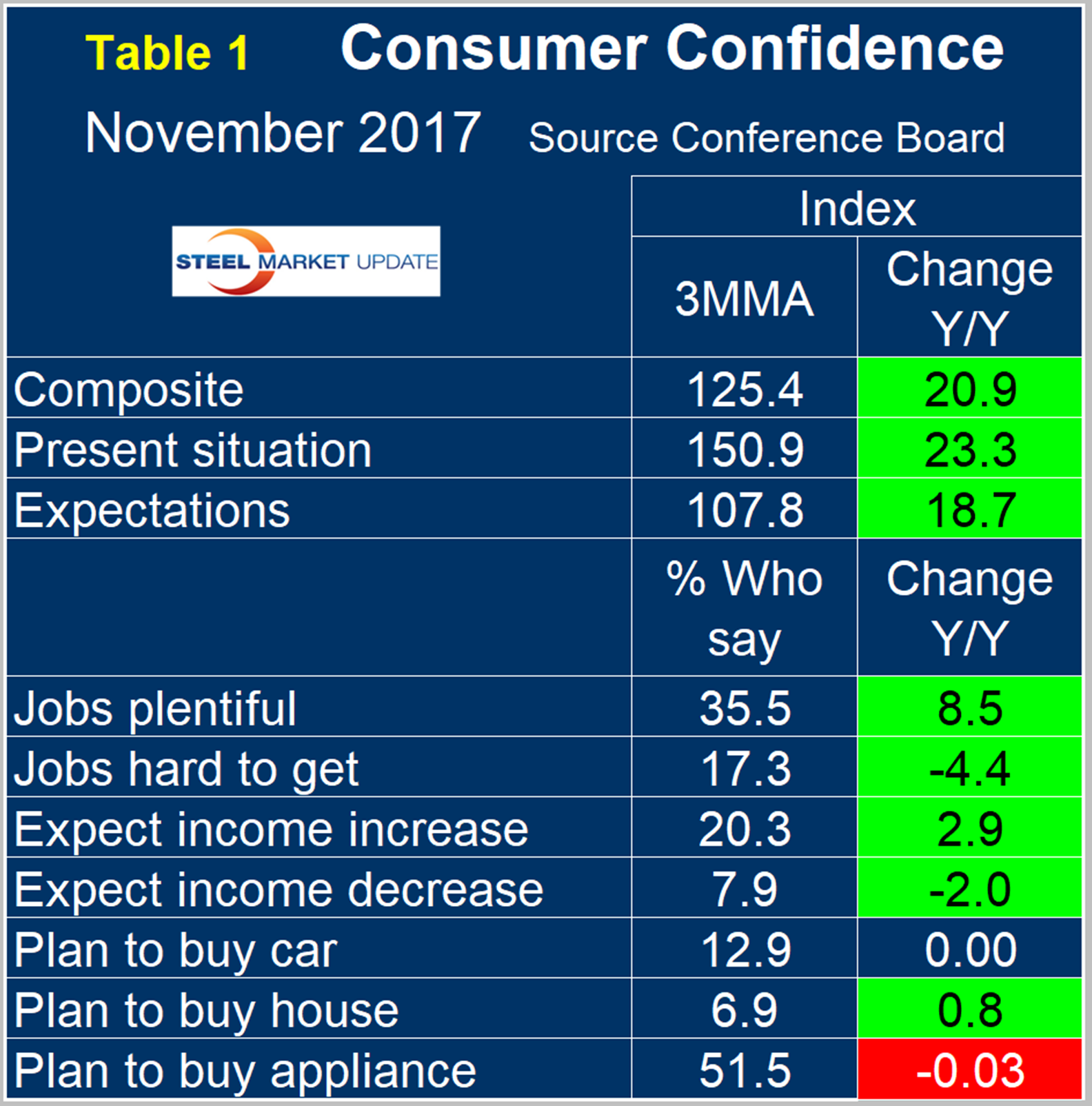Economy

Consumer Confidence at 17-Year High
Written by Peter Wright
November 28, 2017
Consumer confidence increased for a fifth consecutive month and remains at at an extremely high level, reports The Conference Board. The composite value of consumer confidence in November was 129.5 up from 126.2 in October. The last nine months have each been better than at any time since 2001. The three-month moving average (3MMA) increased from 122.4 in October to 125.4 in November, which was 20.9 points higher than in November last year. Consumer’s view of the present situation has been surging since the middle of last year. Consumer confidence is the driver of consumer spending, which is the largest component of GDP and which ultimately drives a large portion of steel consumption.
The source of this data is the Conference Board with analysis by Steel Market Update. Please see the end of this piece for the official news release from the Conference Board and an explanation of the indicator.
In November, the 3MMA of the composite increased by 3.03 to 125.4 points. We prefer to smooth the data with a moving average because of monthly volatility, which in the case of consumer confidence has been quite extreme since the beginning of last year. The composite index is made up of two sub-indexes. These are the consumer’s view of the present situation and his or her expectations for the future. Both are now above their eight-year trend line (Figure 1).
The historical pattern of the 3MMA of the composite, the view of the present situation and expectations are shown in Figure 2.
All three measures are now higher than they were at the pre-recession peak of 2007. The 3MMA of both components of the composite surged from mid-2016 until June this year when expectations declined. Expectations in April were 107.1 on a 3MMA basis and fell to 99.6 in June before recovering to 111.3 in November. Comparing November 2017 with November 2016, the 3MMA of the composite was up by 20.9, the present situation was up by 23.3 and expectations were up by 18.7 (Table 1).
All sub-indices in Table 1 were green in August and September, but in October and November plans to buy an appliance deteriorated slightly year over year. The consumer confidence report includes encouraging data on job availability and wage expectations. It reports on the proportion of people who find that jobs are hard to get and those who believe jobs are plentiful and it measures those who expect a wage increase or a decrease. Since November 2011, both of the employment components have steadily improved. The difference between those finding jobs plentiful and those finding jobs hard to get has been in positive double digits every month since February and in November reached 20.2 percent. Expectations for wage increases have been less consistent, but the differential between those expecting an increase and those expecting a decrease has been in positive double digits since January this year. October was the first time that plans to buy an automobile were negative since March last year, but the negativity was very slight. In November, plans to buy a car were unchanged year over year. Plans to buy a house have been positive year over year for each of the last eight months, and October and November were the first months in which plans to buy an appliance were negative year over year since August last year.
Economy.com summarized as follows: “Consumer confidence rose again in November, according to the Conference Board’s index, gaining 3.3 points and rising to 129.5, its highest level since December 2000. This month saw improvement in consumers’ evaluation of the present situation and economic expectations. Confidence in the labor market continued to rise with more people expecting jobs in the coming six months. Inflation expectations softened another 0.2 point, dropping to 4.5 percent for the coming 12 months. Confidence is up 20.1 points from a year ago.”
SMU Comment: Based on three-month moving averages, this was an excellent report. The employment sub-indexes are good, which will drive personal consumption, the largest component of GDP. This in turn will have a positive effect on steel consumption.
The official news release reads as follows:
The Conference Board Consumer Confidence Index Increased Again
Index Remains at 17-Year High
The Conference Board Consumer Confidence Index®, which had improved in October, increased further in November. The Index now stands at 129.5 (1985=100), up from 126.2 in October. The Present Situation Index increased from 152.0 to 153.9, while the Expectations Index rose from 109.0 last month to 113.3. The cutoff date for the preliminary results was Nov. 14.
“Consumer confidence increased for a fifth consecutive month and remains at a 17-year high (Nov. 2000, 132.6),” said Lynn Franco, Director of Economic Indicators at The Conference Board. “Consumers’ assessment of current conditions improved moderately, while their expectations regarding the short-term outlook improved more so, driven primarily by optimism of further improvements in the labor market. Consumers are entering the holiday season in very high spirits and foresee the economy expanding at a healthy pace into the early months of 2018.”
Consumers’ assessment of current conditions improved moderately in November. The percentage saying business conditions are “good” increased from 34.4 percent to 34.9 percent, while those saying business conditions are “bad” declined from 13.5 percent to 12.7 percent. Consumers’ assessment of the labor market also improved. Those stating jobs are “plentiful” increased from 36.7 percent to 37.1 percent, while those claiming jobs are “hard to get” decreased slightly from 17.1 percent to 16.9 percent.
Consumers’ optimism about the short-term outlook was also more favorable in November. The percentage of consumers expecting business conditions to improve over the next six months increased slightly from 22.1 percent to 22.4 percent, while those expecting business conditions to worsen decreased from 7.0 percent to 6.5 percent.
Consumers’ outlook for the job market was also more upbeat than in October. The proportion expecting more jobs in the months ahead increased from 18.7 percent to 22.6 percent, while those anticipating fewer jobs declined from 11.6 percent to 11.0 percent. Regarding their short-term income prospects, the percentage of consumers expecting an improvement decreased marginally from 20.3 percent to 20.1 percent, while the proportion expecting a decrease was virtually unchanged at 7.6 percent.
Source: November 2017 Consumer Confidence Survey
About The Conference Board: The Conference Board is a global, independent business membership and research association working in the public interest. Our mission is unique: To provide the world’s leading organizations with the practical knowledge they need to improve their performance and better serve society. The monthly Consumer Confidence Survey®, based on a probability-design random sample, is conducted for The Conference Board by Nielsen, a leading global provider of information and analytics around what consumers buy and watch. The index is based on 1985 = 100. The composite value of consumer confidence combines the view of the present situation and of expectations for the next six months. The Conference Board is a non-advocacy, not-for-profit entity holding 501 (c) (3) tax-exempt status in the United States. www.conference-board.org.

Peter Wright
Read more from Peter WrightLatest in Economy

Industry groups praise Senate for passing tax and budget bill
The Steel Manufacturers Association and the American Iron and Steel Institute applauded the tax provisions included in the Senate's tax and budget reconciliation bill.

Chicago PMI dips 0.1 points in June
The Chicago Purchasing Managers Index (PMI) slipped 0.1 points to 40.4 points, in June.

Multi-family pullback drives housing starts to 5-year low in May
US housing starts tumbled in May to a five-year low, according to figures recently released by the US Census Bureau.

Architecture firms still struggling, ABI data shows
Architecture firms reported a modest improvement in billings through May, yet business conditions remained soft, according to the latest Architecture Billings Index (ABI) release from the American Institute of Architects (AIA) and Deltek.

Manufacturing in New York state contracts again
However, companies are growing more optimistic about the future.



